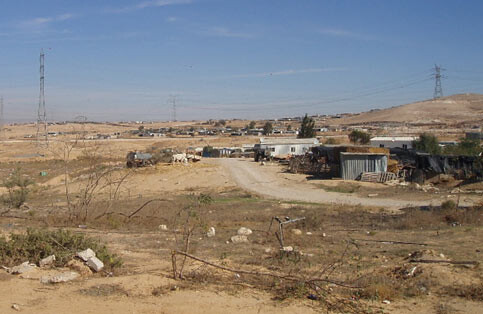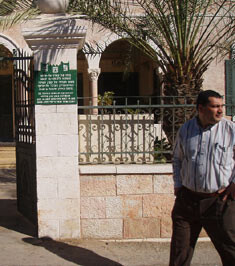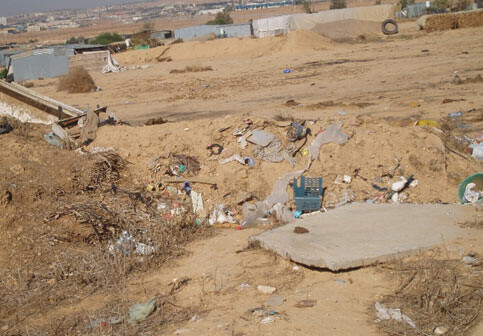The Electronic Intifada 8 January 2006

A couple of kilometres from the town centre, in the so-called greater Beer Sheva area, lies the unrecognised village of Alsr. (Adri Nieuwhof)
More and more, comparisons are being made between the living conditions of Palestinian Bedouins and those in the townships and informal settlements of apartheid South Africa. Human rights advocates Adri Nieuwhof and Bangani Ngeleza visited unrecognised villages in the Nakab (Negev).1 They travelled from Haifa in the North to the villages in the South of Israel. Near Tulkarem they noted how the Wall looked quite friendly from the Israeli side. There is a slope of earth planted with shrubs and flowers from the roadside up to the Wall. It covers the ugly high concrete Wall from the eyes of travellers on the Israeli highway.
Arrival in Bir al-Seba
Near a 100-year old Mosque we meet Faisal who works as a high school teacher and as staff member of the Regional Council For Unrecognised Villages in the Negev (RCUV). About 4,500 Muslims live in Bir al-Seba (known in Israel as Beer Sheva). Their mosque has been desecrated and currently houses the Negev museum. The Muslim community took the desecration of the mosque to court. In an attempt to settle the conflict it was suggested that the mosque become a community centre. This was refused because the Muslim community in Bir al-Seba strongly felt it needed a mosque, which should, in any case, be respected as a sacred place.2

The sign states that the building belonged to a well known historian, Aref el-Aref. It is now owned by a Jewish-Israeli construction company, Beretz Luzon. (Adri Nieuwhof)
On the opposite side of the road are the offices of the RCUV: they are in a large building with several floors, with a green sign at the entrance. This time it says the building was owned by the Bedouin Sheikh Abu-Midein, mayor of Bir al-Seba in 1920. On the ground floor is a shop. The descendants of the Sheikh now live in Gaza.
Pressure on villagers
It turns out that we are not the only visitors to the office. Some representatives of the Shinui party that currently holds 15 out of the 120 seats in the Knesset have come to show interest, maybe as part of their campaign for the coming elections. Minister of Justice Josef Lapid is founder of the party. As a Minister, Lapid can be held accountable for the Israeli government’s tough policies towards the Palestinian people, including the government’s recent imprisonment of Hamas and PFLP members and leaders. These arrests seem clearly aimed at influencing elections in the Occupied Palestinian Territories and are yet another display of the brutal force of the regime.
Suleiman, a fieldworker of the RCUV, joins us after he has met the Knesset members. He has only just recovered from beatings by the police. On 15 November, the police “protected” representatives of the Ministry of Interior who came to distribute home demolition orders to people in the unrecognised village of Bir Almshash. Suleiman heard police commander Ilan Peretz say he could not leave the village like a dog and ordered his men to leave their footprint. The families who were at home not only received the demolition order, but were also confronted in their homes with the violent behaviour of the police. Thirteen people needed hospital treatment after the police left, forty-two people were arrested and detained for some time and six people were placed under home arrest for three months.
It was astonishing to us that Israel puts people from unrecognised villages under house arrest, while their houses are declared “illegal”.
A local journalist was beaten and his pictures confiscated. Suleiman was also taking photos, which were not acceptable to the police. A policeman hit him hard on his arm and the camera flew out of his hand. The policeman continued beating him with a stick, while other colleagues joined in the beatings. As a result, his body and face were badly bruised.
“But look”, he said. “I have recovered fast. And it does not stop me from standing side by side with the people of the unrecognised villages. I am ready for my next arrest by the police. We have to resist the Israeli government policies towards the Bedouins in the Nakab (Negev). That is one thing we can do.”
Life in unrecognised villages
A couple of kilometres from the town centre, in the so-called greater Beer Sheva area, lies the unrecognised village of Alsr. It looks like a shanty town and lies next to a big prison. We park the car near a fenced-in water pump, which is obviously not servicing the village. High voltage power lines hang in a very blue sky over Alsr, which itself has no access to electricity. It is obvious to us that the garbage is not collected in unrecognised villages.
Suleiman tells us about the village. The nearest school is five kilometres away. Some children travel to school on the back of a donkey. In 1948, the Palestinian Bedouins living in Alsr were “asked to move” from Beer Sheva to Alsr.

It is obvious to us that the garbage is not collected in unrecognised villages. (Adri Nieuwhof)
The Bedouins have tried to build a new life in Alsr. A few years ago their black sheep used to graze the land on the other side of the road. This is impossible now, because their land is declared a military zone now. We can still see some cattle between the shacks in Alsr. In the “development plans” for greater Beer Sheeva there is no room for the Palestinian Bedouins in Alsr. Once again they are “asked to leave”. And, if they don’t want to leave, the huge yellow Israeli Caterpillar bulldozers will come to destroy their homes. Suleiman continues, “Before 1948, about 100,000 Palestinian Bedouins lived in the Nakab. During the Jewish military campaigns, their land was taken and 10,000 Palestinians refused to leave. Current Israeli policies are targeted on taking the land of the Palestinian Bedouins that stayed.”
A bit further down the road we stop near a sign indicating the way to the Dead Sea and Dimona. We notice a paved road to the left that leads to a Jewish cemetery, which has plentiful access to water as demonstrated by the green trees in the cemetery. To the right, a dust road leads to the unrecognised village of Khashmzanne, which has no access to running water or electricity. A few days before our visit, one house and its garden were demolished. Suleiman shows us a bare space in the village. There are demolition orders for six other houses in the village. Every week, in different unrecognised villages, a couple of houses are destroyed and some home demolition orders are handed out. It is clear that Israel is avoiding large scale actions in order not to attract too much attention.
Visit to an elder
We then travel to Um Midnam, a village that successfully fought for recognition, although only a part of the village was recognised. UmMidnam is the home of 78-year old Mahmoud, one of the oldest living Palestinian Bedouins. Suleiman and Faisal want us to meet him because he is one of the last Bedouins who can tell us from first-hand experience about the history of Bedouins in the Negev.
The old man and some of the villagers have invited us for tea, which is offered in an open space under a zinc roof in the unrecognised part of the village. We sit down on the colourful comfortable cushions, while a young man serves tea. In the corner, Mahmoud is seated, his walking stick in his hand, wearing the traditional kafiyah Palestinian head dress. With a frail voice he starts to speak.
“I was born in 1914, shortly before the arrival of the British in Palestine. My Bedouin grandparents are from Libya and lived in a tent. My father served in the army of the Ottoman occupying forces and came to Palestine. When I was a boy of seven years old we moved to Gaza and in 1944 we went to live in Bir al-Seba. At first we lived in a tent and soon in a house. In 1948, Israel fought the Palestinians. About twenty Palestinians were killed, but in the end all Palestinians fled the city. This is the reason why parts of my family now live in Ramallah, Gaza, Jordan and Lebanon.”
The future
The old man continues his story: “Ten years ago the Israeli government demolished my home. If they want to demolish it now, they can go to hell. We pay taxes and I can receive medical treatment from the state. I am happy about it because I have problems with my health. I am in a way better off than my family living in a refugee camp in Lebanon. So I say, Israel is a good country but it has two disasters: land confiscation and home demolitions.”
The other men present participate in the discussion and share their visions of what they would like to see in the future.
“We live with about 1,000 people in the unrecognised part of Um Midnam. We want our land to be recognised so that we are officially part of our village. We want a secondary school for our youth. We want a paved road, because the ambulance is not coming to the village when someone needs urgent treatment. We have to go with the sick person to the main road and wait there for the ambulance. We want running water. Right now we paid ourselves for a water pipe from the recognised part of the village to the unrecognised part. However, we have to pay a higher price for the water we use. We want running water for an affordable price. We need jobs for our people. Some can survive in the transport sector but most men are unemployed. We want to be involved in the planning, because we want to be an agricultural village so that we can keep our sheep. “This is our land. We are not going to move!”
Adri Nieuwhof and Bangani Ngeleza are independent consultants and human rights advocates from respectively the Netherlands and South Africa.
Endnotes
[1] See also Bangani Ngeleza and Adri Nieuwhof, Unrecognised villages in the Negev expose Israel’s apartheid policies (21 December 2005)
[2] Bir al-Seba knows two mosques: Sanctity Denied, The Destruction and Abuse of Muslim and Christian Holy Places in Israel, Arab Associaltion for Human Rights, December 2004.
Related Links





